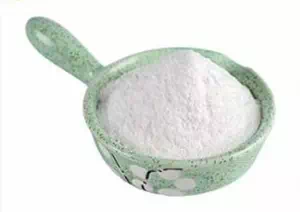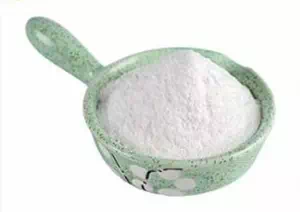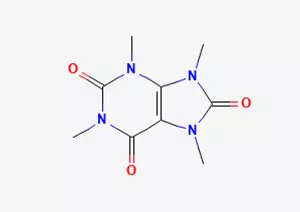All Categories



theacrine CAS 2309-49-1, theacrine, CAS 2309-49-1
In the vast world of phytochemistry, theophylline (1,3,7, 9-tetramethyluric acid), as a unique purine alkaloid, exudes its mysterious and remarkable radiance.
CAS : 2309-49-1
Formula : C9H12N4O3
Mol. wt. : 224.22
EINECS : 218-994-1
Chemical Name | Theacrine |
Other Name | Theophylline; Tetramethyluric acid; 1,3,7,9-Tetramethyluric acid |
CAS | 2309-49-1 |
EINECS | 218-994-1 |
Type | Cosmetic raw materials; Pharmaceutical, pesticide, dye intermediates; Pharmaceutical raw materials; Organic raw materials |
Molecular Formula | C9H12N4O3 |
Molecular Weight | 224.22 |

Melting point | 226℃ |
Boiling point | 365.61°C (rough estimate) |
density | 1.3055 (rough estimate) |
refractive index | 1.6300 (estimate) |
storage temp. | Sealed in dry,Room Temperature |
solubility | Chloroform (Slightly), Methanol (Slightly) |
In the vast world of phytochemistry, theophylline (1,3,7, 9-tetramethyluric acid), as a unique purine alkaloid, exudes its mysterious and remarkable radiance. It is a wonderful substance that truly exists in the leaves of wild Camellia (Camellia kucha Hung T. Chang). When we delve deeper into its molecular structure, we will find that it ingeniously has an extra methyl group compared to the common caffeine found in tea.
It is precisely this seemingly minor yet highly significant methyl difference that enables theophylline to exhibit distinct physiological functions and health benefits from caffeine. This unique feature is like a brilliant new star, shining brightly in the vast starry sky of academia, attracting the high attention of many scholars in both the academic and medical fields. Filled with curiosity about the unknown and enthusiasm for exploration, they all threw themselves into in-depth research on theophylline, attempting to lift its mysterious veil and uncover the hidden secrets behind it.
In the vast plant system of tea trees, alkaloids play a crucial role, and the main active component among them is purine alkaloids. The purine alkaloids in tea plants are like a rich and colorful family, which includes members such as caffeine, 1,3,7, 9-tetramethyluric acid, theobromine and theophylline.
When we focus our attention on different types of tea, we will find that the types and contents of purine alkaloids they contain vary. In the fresh and elegant green tea and the long-lasting Pu 'er tea, only caffeine and a small amount of theobromine are contained. Among them, the caffeine content is approximately stable between 2.5 and 4%, as if it were a unique "code" bestowed upon these teas by nature. However, in cocoa tea, the situation is different, among which only theobromine stands out. The composition of Maoye tea has its own unique characteristics. Besides containing theobromine, it also has a small amount of caffeine.
However, the situation of Pu 'an tea is rather special. It only contains tetramethyluric acid, but its content is relatively small, accounting for only 0.79%, which is less than half of the tetramethyluric acid content in bitter tea. Bitter tea, on the other hand, is like a "rich mine" of tetramethyluric acid, with tetramethyluric acid being the most abundant, accounting for approximately 2%. Secondly, there is caffeine, accounting for between 0.6% and 1%. Another component is theobromine, but its content is negligible and may even be difficult to detect in some cases. Through such a detailed analysis, we can clearly know that tetrmethyluric acid is mainly hidden in the leaves and peels of the bitter tea tree, just like a reclusive sage, waiting for people to discover its value.
In 1937, during those years brimming with the spirit of exploration, Johnson, with his indomitable perseverance and outstanding scientific research capabilities, successfully isolated tetrmethyluric acid from millions of pounds of vast tea leaves, just like panning for gold in the sand. In that era when science was not yet highly developed, this achievement was undoubtedly a great feat.
Tetramethyluric acid, a purine alkaloid found in bitter tea leaves, was like a forgotten treasure in the corner and remained largely unknown until the end of the last century. However, with the passage of time and the continuous deepening of scientific research, it has gradually come into people's view and attracted widespread attention.
From a chemical perspective, 1,3,7, 9-tetramethyluric acid has a clear chemical formula - C9H12N4O3, its CAS number is 2309-49-1, its melting point is 228-229 ℃, and its relative molecular mass is 224.217. When we closely observe its molecular structure, we will find that it is extremely similar to that of caffeine, as if it were a pair of "twin brothers" carefully designed by nature. The only difference lies in the fact that tetramethyluric acid has an additional methyl group.
Even more astonishingly, both of them coexist in the leaves of the Camellia oleifera plant, and under certain conditions, they can transform into each other, just like a wonderful chemical "dance", performing the wonders and mysteries of nature in the microscopic world.

In the fields of medicine and biochemistry, theophylline, as a methylpurine drug, holds a unique and significant position. Its mechanism of action is complex and diverse, exerting multiple influences on the physiological functions of the human body.
From the perspective of its pharmacological effects, theophylline has a significant effect in enhancing cardiac function. It can act on specific targets of the heart, regulate the contraction and relaxation processes of the heart, enhance the heart's pumping capacity, just like injecting a powerful force into the heart, making blood circulation smoother and more efficient. At the same time, theophylline also has diuretic properties. It can affect the physiological functions of the kidneys, increase the production and excretion of urine, help the human body eliminate excess water and metabolic wastes, and maintain the water and salt balance in the body.
In terms of the cardiovascular system, theophylline can dilate coronary arteries. The coronary arteries are the vital blood vessels that supply blood to the heart. The role of theophylline is like opening up wider channels for these blood vessels, allowing more blood to flow smoothly to the heart, providing sufficient oxygen and nutrients for myocardial cells, and ensuring the normal operation of the heart. In addition, theophylline can also relax the bronchial smooth muscle blocks, which is crucial for people with respiratory diseases. It can relieve the spasm and contraction of the bronchi, make the airway more unobstructed, allow air to freely enter and exit the lungs, and alleviate the symptoms of breathing difficulties.
Not only that, theophylline can also stimulate the central nervous system. It can activate specific nerve cells in the central nervous system, enhance the transmission of neural signals, improve a person's mental state, and increase alertness and reaction ability. For this reason, theophylline has extensive applications in medical clinical practice. It is often used to treat bronchial asthma. By relaxing the bronchial smooth muscle and dilating the coronary arteries, it alleviates the symptoms of breathing difficulties in patients. For patients with emphysema, theophylline can help improve the ventilation function of the lungs and reduce the burden on the lungs. In the treatment of bronchitis, it can also play an anti-inflammatory and bronchodilating role. In addition, for cardiogenic dyspnea, theophylline provides more support to the heart by enhancing cardiac function and dilating coronary arteries, thereby alleviating the patient's discomfort.
In daily life, caffeine, which we are familiar with, also has unique properties and functions. Tetramethyluric acid is an impurity in high-concentration caffeine, which itself is a bitter, white, crystalline xanthine alkaloid. This substance has a stimulant effect and can have a significant impact on the physiological functions of the human body.
Caffeine is relatively easy to repair the prevention of acetylcholinesterase. Acetylcholinesterase plays a key role in the transmission process of neurotransmitters. The effect of caffeine on it may interfere with the normal transmission of neural signals, thereby generating a series of physiological effects. In some plants, the caffeine content varies depending on the species of the plant and its growing environment. It is widely present in the seeds, leaves and fruits of certain plants, which form a self-protection mechanism with the help of caffeine, a natural chemical substance. Caffeine is a pure natural insecticide. When some insects that feed on plants consume the parts of plants containing caffeine, caffeine can paralyze their nervous systems and even cause their death, thereby protecting the plants from harm.
For humans, high levels of caffeine are a powerful stimulant for the central nervous system. When we consume beverages or foods containing caffeine, it is quickly absorbed into the bloodstream and then reaches the brain along with the blood circulation. In the brain, caffeine can temporarily eliminate drowsiness, making us feel refreshed and restoring a clear state of consciousness. It's like injecting a burst of vitality into the brain, enabling us to stay alert and focused when we are tired or sleepy.
Not only that, high levels of caffeine are also energy agents for the heart and respiratory system. It can stimulate the beating of the heart, enhance the contractility of the heart and increase the heart rate, thereby providing more oxygen and nutrients to various organs of the body. At the same time, caffeine can also stimulate the respiratory center, increase the frequency and depth of breathing, enhance the ventilation volume of the lungs, and enable the body to obtain more oxygen. In addition, caffeine has a diuretic effect. It can promote the production and excretion of urine by the kidneys, helping the human body eliminate excess water and metabolic waste.
However, it should be noted that high doses of caffeine are toxic. Excessive intake of caffeine may lead to a series of adverse reactions, such as palpitations, insomnia, anxiety, gastrointestinal discomfort, etc. In severe cases, it may even be life-threatening.
Interestingly, the effect of theophylline is similar to that of caffeine. They can all help relieve fatigue to a certain extent and make people feel energetic. When we feel tired, consuming beverages containing theophylline or caffeine often can quickly improve our mental state, significantly enhancing energy and physical performance. Moreover, they also play a certain role in reducing anxiety. In modern life, people are confronted with all kinds of pressure and anxiety. Consuming an appropriate amount of theophylline or caffeine can help us relieve these negative emotions and make our mood more peaceful and comfortable.
More deeply, theophylline and caffeine also have unique manifestations in interacting with human hormones and natural metabolic processes. They can work in coordination with the body's natural metabolic processes to provide more lasting energy. This supply of energy is not merely a brief excitement, but enables us to maintain a good physical condition and mental outlook for a relatively long period of time. Meanwhile, they can also enhance mental clarity, making our thinking more agile and our attention more concentrated. Theophylline and caffeine can also play a positive role in improving mood and motivation, enabling us to face various challenges in life more positively.
Specifically, tea secretion activates dopaminergic receptors D1 and D2. Dopaminergic receptors play a crucial role in the nervous system. When theophylline activates these receptors, it triggers a series of complex biochemical reactions, ultimately leading to an increase in dopamine secretion. Dopamine is an important neurotransmitter that can generate more energy and make us feel energetic. Meanwhile, dopamine can also improve our mood, making us feel happy and allowing our minds to be more concentrated and clear.
In addition, tea secretion also has the effect of inhibiting the production of adenosine. Adenosine is a chemical substance involved in biochemical processes that promote calmness and relaxation. When the level of adenosine in our bodies decreases, the calm and relaxed state originally caused by adenosine will be disrupted, replaced by a higher level of alertness, stronger attention, better physical coordination, as well as improved cardiovascular and anaerobic performance. These changes enable us to be more sensitive to the surrounding environment and better cope with various physical and mental activities after taking in theophylline.
* Prompt reply and 24 hours online, professional team to provide best price and high quality product.
* Sample testing support.
* Every batch of products will be tested to ensureits quality.
*The packing also can be according the customers` requirment.
*Any inquiries will be replied within 24 hours.
*we provide Commerical Invoice, Packing List, Bill of loading, COA , Health certificate and Origin certificate. If your markets have any special requirements, let us know.